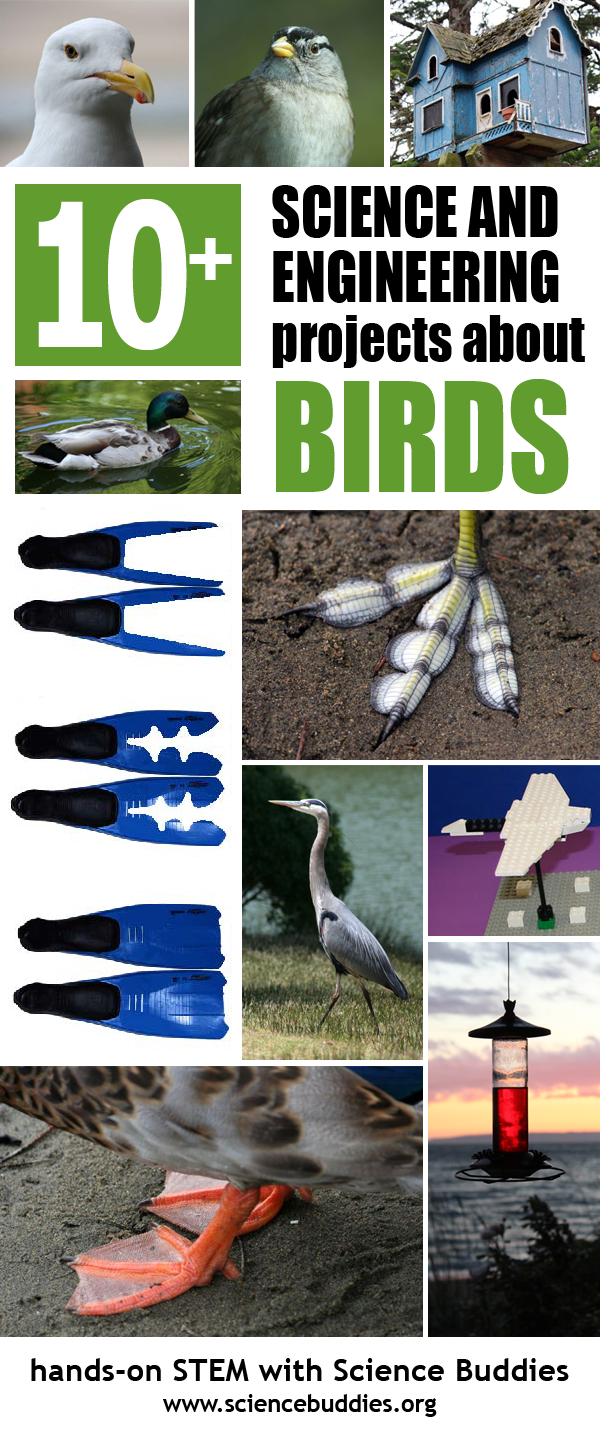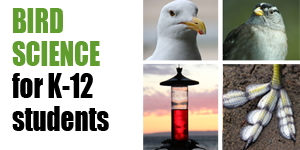10+ Backyard Bird Science Projects
From bird seed to bird feet, there are exciting science projects you can do with students of all ages to encourage interest in birds. Keeping a few key tips in mind, your summer bird watching may also help build your student's science skills and reinforce important observation and recordkeeping skills. Add a creative angle to summer bird watching with a display board project to share at school or hang up as a reminder of a summer of birds!

Ten Plus Science and Engineering Projects About Birds--Hands-on STEM with Science Buddies. www.sciencebuddies.org
Bird Science Projects and Activities for Students
Students interested in or inspired by birds can engage in bird-focused science activities and observation all year long. But summer break and summer weather can make it especially easy to get involved with a birding project. Try one of the science projects or activities below with your students to help foster an interest in and greater awareness of birds.
- Can You Predict a Bird's Lifestyle Based on Its Feet?: by carefully observing the different "feet" of the birds you spot, you and your students can think and talk more about how "feet" (or other physiological adaptations) relate to bird behavior and lifestyle, including where birds live (their habitat) and what they eat. Tip: keep binoculars on hand for bird spotting in the backyard or at the park. Practice being very quiet and still so birds in the area do not fly off. Get a field guide (or several) and try and find what you see and encourage your kids to make a list or chart to track their bird spotting. Your summer efforts might fuel a lifelong interest!
- The Swimming Secrets of Duck Feet: continuing with the foot focus, head to a local pond or lake where you and your students can observe ducks, geese, and other birds that swim and/or live near water. How do a duck's feet differ from a bird you might have observed in your backyard? Why? Tip: take binoculars with you, as well as pen and paper, and encourage students to sketch what they see and diagram, as best they can, the bird feet they encounter. (This kind of observation and sketching is excellent practice and can also help with identification later using a field guide.)
- How Sweet It Is! Explore the Roles of Color and Sugar Content in Hummingbirds' Food Preferences.: this is a wonderful project for families whose yards are home to hummingbirds. In this science project, students experiment with hummingbird feeders in different colors to see if hummingbirds naturally are drawn to certain colors—or if they are more interested in the sweetest food.
- What Seeds Do Birds Prefer to Eat?: different species of birds prefer different kinds of bird seed. You and your budding birders may even find that different types of birds prefer to eat from different kinds of feeders. This science experiment will help you get started with a food-focused experiment. If you want to encourage a certain kind of bird (that you know lives in your area) to visit your backyard, what kind of feeder and seed should you use? Tip: make a list of the birds you have seen in your area or in your yard, and do some preliminary background reading about the type of bird seed and feeder that might work best for those birds. Then set up an experiment with your kids to compare either different types of seed or different feeding structures.
- How Tweet It Is: Bird Songs in Classical Music: observing birds involves more than just seeing! Listening to different bird sounds and songs can be really important in learning to identify and differentiate birds in your area. Some birds, like the mockingbird, have very distinct bird songs that you will quickly learn to recognize. Even common birds like the White-crowned Sparrow have a call that will quickly become familiar once you associate the sound with the bird. In this science project, students listen to classical music and identify places where impressions and/or imitations of bird song appear—and what instruments are used to create these sounds.
- Why Do Birds Fly in a V-formation?: this is a great hands-on project for a birder who enjoys building. Using LEGO® bricks, students can model birds and explore why certain flight grouping patterns might be common. What kinds of assistance or protection does flying in a group offer?
- With a Little Bread as Bait, Can You Make a Bird Migrate?: in this experiment, students can experiment to find out how quickly birds will move when the location of a food source changes.
- Build a Bird Feeder to Study Birds: use recycled and craft materials to make a feeder for the backyard and be prepared to observe the birds that visit.
- Build a Bird Nest: learn more about bird nests and gather materials from outside to try building your own.
Making Connections
Increasing awareness of birds in your neighborhood may also broaden your student's understanding of environmental and conservation issues. Students interested in biodiversity may enjoy projects like these:Students who are interested in birds and are looking for a more advanced or in-depth science project focused on birds, may want to explore the following environmental and bird-science projects:
- Do Migratory Birds Like It Hot?
- Are We There Yet? Test How Migratory Birds Navigate
- Here Today, Gone Tomorrow: Saving Migratory Animals
Related Reading and Field Guides
For a great summer reading pick for kids interested in birds, see our reviews of Look Up! Bird-Watching in Your Own Backyard by Annette LeBlanc Cate and The Boy Who Drew Birds: A Story of John James Audubon by Jacqueline Davies. For additional bird-centered picture books for younger children, see A Nest is Noisy and An Egg is Quiet.
As you begin birding projects with students, be sure and have one or more field guides on hand. Featuring 300 birds common in the US and Canada, a field guide like The Young Birder's Guide to Birds of North America (Peterson Field Guides), especially designed for younger bird watchers, may be a good starting point. As your students get more interested in birding, however, you will want to explore larger and more comprehensive field guides. The following field guides are examples of field guides specific to North America. Field guides for other parts of the world are also available, as are field guides dedicated to specific geographic sections of North America (like the this one) and specific states.
Finding birds in a field guide can be difficult when first starting out. As students become more familiar with birds and more skilled in their observational skills, looking up and identifying birds using a guide will get easier. As you begin birding with your students, plan to work on solving a bird's identify as a family and agree to look again more carefully at certain characteristics or identifying marks if you see the bird again.
Keep a list! Bird enthusiasts often keep lists of birds they have seen and birds they hope to see. Encouraging this kind of recordkeeping from your students is a good science practice and will help reinforce the summer birding experience. (Tip: you may be able to download a printable checklist list of birds in your area from a local parks and recreation website.)
Encourage Creative Tracking
In addition to using a checklist and logging bird sightings in a field notebook, creative kids may want to make a display board on which they track their sightings, photos, sketches of birds, and other bird-oriented data they gather over the summer. (Use a regular sheet of poster board that they can add to all summer long, or consider setting up a dedicated family "birding" bulletin board onto which notes, lists, drawings, and sketches can be tacked.)
A "poster"-style account of a summer spent watching birds makes a wonderful back-to-school project that young birders may be able to share with their classmates once school resumes. Plus, this kind of project lets kids combine their creative skills with their science observation and research skills. What a great way to record a summer spent with binoculars, a field guide, and a notebook to track birds in the area! (See Creative Summer Science: A Science Collection for more inspiration.)
Getting Involved
Families may also be interested in participating in citizen science projects related to birds in their area. These projects encourage students and scientists of all ages to put their observation (and photo snapping) skills to use to contribute to data repositories about certain species. To learn more about citizen science, see Citizen Science for Earth Day and Calling Naturalists of All Ages: Citizen Science Projects for the Whole Family.
Pin this collection:

Grid of sample images from bird science projects
You Might Also Enjoy These Related Posts:
- Teach Genetics and Heredity with Free STEM Lessons & Activities - Genetics Science Projects
- Star Wars Projects for May the 4th Be With You Science
- 25+ Earth Day Science Experiments and Activities
- Arduino Science Projects and Physical Computing
- Spring Science Projects: 26 Science Experiments for Spring
- 25+ Robotics Projects, Lessons, and Activities
- March Madness Basketball Science Projects: Sports Science Experiments
- 15 Density Science Experiments


















